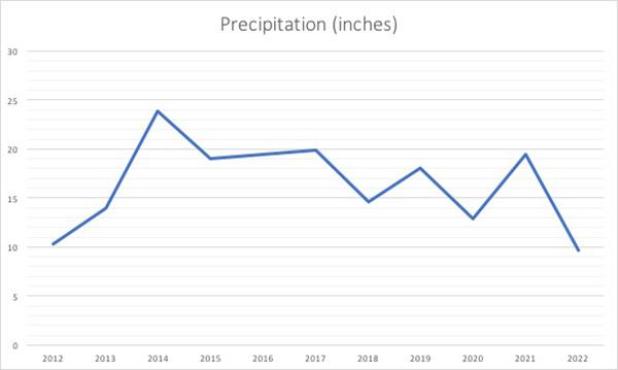
A water drop falls in Holyoke from an icicle upon Hometown Liquors’ awning the afternoon of Wednesday, Jan. 4. Data compiled by Dan Kafka of the National Weather Service’s Cooperative Observer Program indicate Phillips County received just over half of its average 18 inches in precipitation. — Andrew Turck | The Holyoke Enterprise

This graph shows annual precipitation for Phillips County recorded by Dan Kafka for the past decade. Before 2022, the county hit another low in 2012 with 10.34 inches. — Andrew Turck | The Holyoke Enterprise
128- YEAR LOW
By Andrew Turck
The Holyoke Enterprise
“It’s always in the twos,” according to Phillips County Commissioner Tom Timm regarding drought: 2002, 2012 and now in 2022, when the county seems to have experienced its driest year since recording began in 1895.
This designation, through the National Integrated Drought Information System, accounts for rainfall from January to November of last year. Established March 2014 through Public Law 113-86, this system is a project operated federally through the National Oceanic and Atmospheric Administration. Its purpose, the act states, is to provide information “for more timely” decisions aimed at reducing “drought related impacts and costs.”
Timm, who ranches cattle, noted, “Everybody’s in the same situation I’m in.”
“Grass is short, feed’s high,” he said. “There’s hardly any feed in the country as far as dryland feed. There’s nobody raising any dryland crops.”
Dan Kafka of the National Weather Service’s Cooperative Observer Program stated in an email he began recording in 2007 as “just one in a long line of people who have done this in Holyoke” since at least the early 20th century. Last year, he began volunteer observations for the international Community Collaborative Rain, Hail and Snow Network, who compiles drought monitor data through “actual observations, radar estimates, remote monitoring sites” and more.
Drought Information System data regarding Phillips County precipitation, he stated in an email, “would seem consistent” with his recordings for 2022. By the end of December, he recorded 9.69 inches of precipitation for Phillips County, just over half of the county’s 18-inch average, according to data compiled through government sources by Sperling’s Best Places.
One hundred percent of Phillips County, according to the Drought Information System website, drought.gov, is designated D1 for Moderate Drought with stunted rangeland, damage to dryland crops and an increase in wildfires. Nearly 90 percent is designated one step further at D2 – Severe Drought – where farmers reduce planting, ranchers sell cattle and water levels decrease. Just under 60 percent is designated D3 – Extreme Drought – where pasture conditions become worse and reservoirs drop well below average. Though the website does not designate any percentage in the county D4 – Exceptional Drought – Wesley Jenkins, executive director of the U.S. Department of Agriculture’s Farm Service Agency for both Phillips and Sedgwick counties, said parts of both Phillips and Sedgwick to the north have reached this designation. With D4, the highest level, dust storms and topsoil removal become common, with significant economic losses for both agriculture and recreation.
Daniel Palic of the National Resources Conservation Service believes “we’re going on the third year” when drought is concerned. As the agency’s resource team lead district conservationist, he also covers both Phillips and Sedgwick counties.
“Me and my brothers have some river-bottom ground in Sedgwick County just outside of Julesburg,” he said, referring to South Platte River territory. “There are some warm-water sloughs that run through it... I’ve been going down there for over 40 years and they’ve been dry in a lot of spots.”
According to Palic, he had never before seen the slough without water. For some time beginning around August, he added, one could “darn near cross” the river “in tennis shoes.” December’s snowfall “definitely saved it,” he said, eventually filling the South Platte reservoir with precipitation.
Dry conditions faced by Phillips and Sedgwick counties, according to Adam Lang, communications coordinator for the Drought Information System, have remained an issue for the western United States over the past 20 years.
“Some people are calling it a mega-drought, others are calling it aridification,” he said. “It’s exacerbated by climate change.”
Back in Phillips County, Timm focused on the more local impacts. With the hits to agriculture, he said, residents spend less money, lowering the county sales tax. In his words, “You just kind of hope for the best.”
“Maybe the prices will be good,” he said, “since you don’t have as much.”
For more information, go to www.drought.gov/states/Colorado/county/Phillips.
